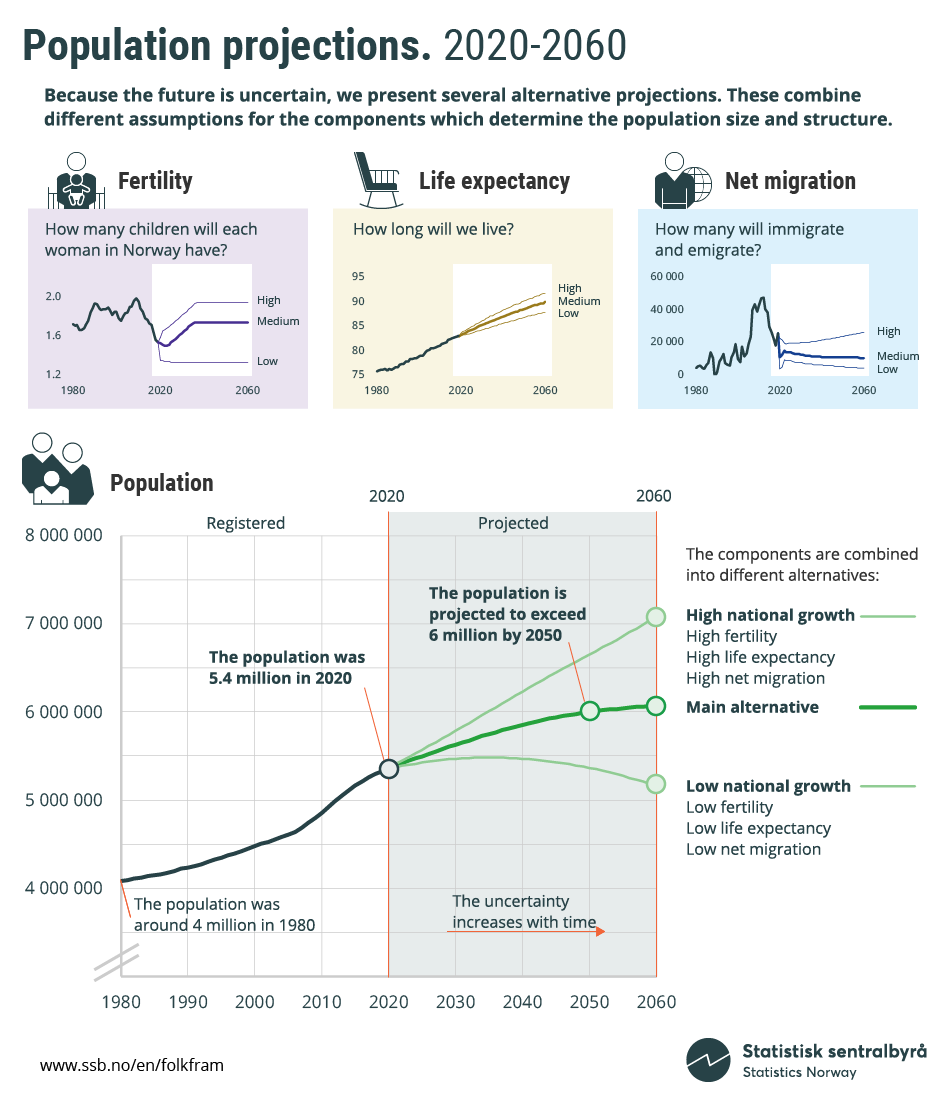Updated
Corrected:
Next update
Not yet determined
Key figures
approx. 6.1
million inhabitants expected in Norway in 2060 (main alternative)
See selected tables from this statistics
Table 1
Total population January 1. Registered 2020 and projected in three alternatives
| Registered 20201 | Projected alternative2 | |||
|---|---|---|---|---|
| Main alternative (MMM) | Low alternative (LLL) | High alternative (HHH) | ||
| 1Total population registered per January 1 2020. | ||||
| 2Refers to high and low national growth alternatives. | ||||
| Total population | 5 367 580 | |||
| 2025 | 5 500 000 | 5 430 000 | 5 570 000 | |
| 2040 | 5 860 000 | 5 470 000 | 6 230 000 | |
| 2060 | 6 070 000 | 5 160 000 | 7 080 000 | |
| 2100 | 6 250 000 | 4 020 000 | 9 290 000 | |
Table 2
Fertility
| Registered 2019 | Projected alternative1 | |||
|---|---|---|---|---|
| Main alternative (MMM) | Low alternative (LMM) | High alternative (HMM) | ||
| 1Refers to high and low fertility alternatives. | ||||
| Total fertility rate | 1.5 | |||
| 2025 | 1.5 | 1.3 | 1.7 | |
| 2040 | 1.7 | 1.3 | 1.9 | |
| 2060 | 1.7 | 1.3 | 1.9 | |
| 2100 | 1.7 | 1.3 | 1.9 | |
| Live births | 54 495 | |||
| 2025 | 55 000 | 48 000 | 61 600 | |
| 2040 | 60 400 | 46 200 | 67 500 | |
| 2060 | 56 600 | 38 100 | 68 200 | |
| 2100 | 57 400 | 32 200 | 74 400 | |
Table 3
Life expectancy
| Registered 2019 | Projected alternative1 | |||
|---|---|---|---|---|
| Main alternative (MMM) | Low alternative (MLM) | High alternative (MHM) | ||
| 1Refers to high and low life expectancy alternatives. | ||||
| Life expectancy at birth men | 81.2 | |||
| 2025 | 82.6 | 81.7 | 83.5 | |
| 2040 | 85.6 | 83.7 | 87.3 | |
| 2060 | 88.9 | 86.0 | 91.3 | |
| 2100 | 93.4 | 89.7 | 96.6 | |
| Life expectancy at birth women | 84.7 | |||
| 2025 | 85.7 | 84.9 | 86.4 | |
| 2040 | 88.1 | 86.4 | 89.7 | |
| 2060 | 90.9 | 88.4 | 93.2 | |
| 2100 | 94.9 | 91.4 | 98.0 | |
| Deaths | 40 684 | |||
| 2025 | 42 100 | 44 900 | 39 400 | |
| 2040 | 52 800 | 57 300 | 48 800 | |
| 2060 | 61 600 | 65 300 | 58 300 | |
| 2100 | 65 200 | 66 300 | 64 700 | |
Table 4
Immigration and emigration
| Registered 20191 | Projected alternative2 | |||
|---|---|---|---|---|
| Main alternative (MMM) | Low alternative (MML) | High alternative (MMH) | ||
| 1The number of immigrations and emigrations is lower than in the official statistics, as only one migration per calendar year per person is used in the projections. | ||||
| 2Refers to high and low immigration alternatives. | ||||
| Immigration | 50 868 | |||
| 2025 | 43 500 | 36 900 | 51 200 | |
| 2040 | 40 100 | 32 200 | 55 400 | |
| 2060 | 37 200 | 25 900 | 64 600 | |
| 2100 | 36 900 | 18 300 | 83 300 | |
| Emigration | 25 547 | |||
| 2025 | 29 800 | 28 200 | 31 800 | |
| 2040 | 29 000 | 26 200 | 34 100 | |
| 2060 | 26 700 | 21 800 | 38 400 | |
| 2100 | 24 800 | 15 200 | 49 900 | |
| Net migration | 25 321 | |||
| 2025 | 13 700 | 8 700 | 19 300 | |
| 2040 | 11 000 | 6 000 | 21 300 | |
| 2060 | 10 500 | 4 100 | 26 300 | |
| 2100 | 12 100 | 3 100 | 33 400 | |
About the statistics
National population projections are calculations of how the population in Norway will potentially develop over time, given different assumptions about fertility, mortality, immigration and emigration. Read about results, methods and assumptions in the report Norway's 2020 population projections.
Definitions
-
A population projection is an estimate of the future size and composition of a population, given certain assumptions of future fertility, life expectancy, immigration and emigration. The term projection is used for any estimate of the future population, including less likely ones. A prognosis or forecast is an estimate of the most probable future population size and composition.
Statistics Norway publishes several projections, but the MMM alternative, which assumes the medium level for each component, is what we assume to be most plausible.
The various alternatives and terms used in the population projections are described in the projections report (see link under 'Relevant documentation').
-
Not relevant.
Administrative information
-
Name: National population projections
Topic: Population
-
Research department, Unit for Public Economics and Demographic Models
-
Not relevant.
-
The national population projections are published biennially.
-
Statistics Norway reports projections to Eurostat and the United Nations, among others.
-
The population projections utilize aggregated individual-level data on population size, births, deaths and migration from Statistics Norway’s population statistics. The results from the projections are stored in the StatBank at Statistics Norway and as separate files. Aggregated data may be downloaded electronically from the StatBank.
Background
-
The population projections aim at informing planning and public debate on population issues.
Statistics Norway has produced population projections regularly since the 1950s. Previous population projections can be found here, and in the StatBank.
-
The most important users of Statistics Norway's population projections are public and private planning bodies at the municipal, county and central government levels, as well as researchers, politicians, journalists and the general public. The projections are also used internally at Statistics Norway, for example as input in macroeconomic models.
-
Not relevant.
-
The population projections are published in accordance with international standards. The Norwegian figures are more detailed (immigration category, country group and period of residence) than what is commonly published in most other countries.
-
There are no specific rules regulating the population projections, but the production process of the projections is based in the Norwegian Statistics Act of 2019.
-
Although there is no separate EU regulation in this field, a collaboration exists between Norway and Eurostat. Eurostat produces population projections for the EU and Norway on a regular basis. These projections differ from those produced by Statistics Norway.
Production
-
To project the population, assumptions are needed on future fertility, mortality and international migration. After the assumptions are made, the Norwegian population is projected using the cohort component model BEFINN.
The methods used are further described in the projections report (see link under 'Relevant documentation').
-
The population projections utilize aggregated individual-level data on population size, births, deaths and migration from Statistics Norway’s population statistics. We use data categorized by age, sex, immigrant background and country group of origin for 1 January each year, in addition to figures on births, deaths, immigration and emigration by age and sex.
No samples are used. The projections utilize the whole population in estimations.
The methods used in the population projections are described in detail in the projections report (see link under 'Relevant documentation').
-
No data are collected specifically for the purpose of making population projections.
-
Not relevant.
-
Not relevant.
-
At a national level, previous versions of the population projections are comparable. Though country groups are not entirely comparable over time, since the definition and the number of groups have varied.
In comparing results from the population projections to the general population statistics at Statistics Norway, two main differences stand out:
- The projection models project the population from 1 January one year to 1 January the year after. This means that individuals who move between Norway and other countries several times during one year only contribute one move. Consequently, somewhat fewer migrations are used in the population projections compared to the numbers that are published in the general population statistics.
- The age definitions are not the same in the projections and the general population statistics. While the general population statistics use age at time of event (e.g. birth, death or migration), the projections use age at the end of the year. This means that the age-specific rates and probabilities used in the projections – as well as the life expectancy figures – may differ slightly from what is published in the population statistics.
Accuracy and reliability
-
There is marked uncertainty about whether the assumptions used in making the population projections will accurately reflect future demographic trends. Over the past decade, future immigration has proven to be the most difficult component to project. This is also likely to be the case in the years ahead. Fertility and mortality rates can also be very different to what is projected.
Models are simplifications of reality, and as such may only capture a few key mechanisms. There are a multitude of other conditions that will affect population development which are not considered.
Errors in the population statistics system are usually modest in Norway and play a minor role in the projections.
In general, uncertainty increases with time. For more information, see links under ‘Relevant documentation’.
-
Not relevant.
Analyses, articles and publications

A historic shift: More elderly than children and teenagers
Published 3 June 2020Strong ageing, lower population growth, as well as a larger and older immigrant population. According to the 2020 national population projections, these are some of the important changes that will occur this century. In the short term, the Corona pandemic is not expected to increase mortality rates, but fertility and immigration are expected to be temporarily lowered.
Read this article
Norway’s 2020 population projections
Published 3 June 2020The 2020 national population projections show lower population growth and stronger ageing than in the previous projection produced in 2018. Nevertheless, the main alternative suggests that Norway will experience population growth throughout this century, from around 5.4 million today to 6.1 million in 2060, and around 6.3 million in 2100.
Read this publication
Ways to project fertility in Europe
Published 13 May 2020National statistical offices responsible for population projections should regularly evaluate their work. Norway is currently considering changing the way fertility is projected.
Read this publicationThe accuracy of Statistics Norway’s national population projections
Published 26 March 2021Statistics Norway projects the population by age, sex and immigrant background at the national level. This paper examines the accuracy of the Norwegian population projections produced between 1996 and 2018.
Read this publicationContact
-
Statistics Norway's Information Centre
-
Inquiries about national projections
-
Inquiries about regional projections
-
Michael Thomas
-
Ane Margrete Tømmerås

